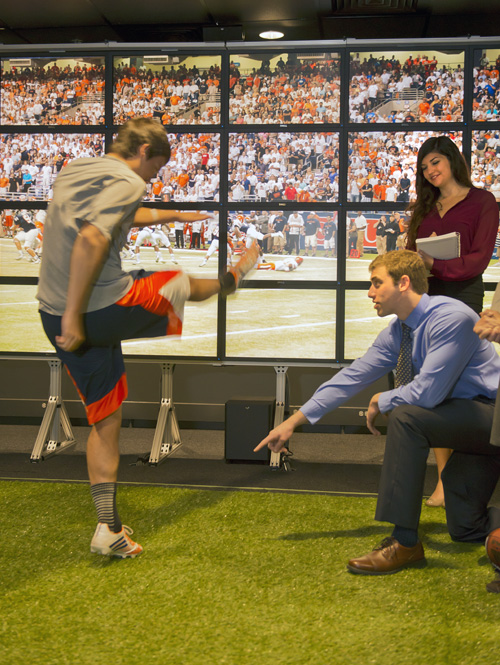The Science and the Art of Kicking It
The Football Kicking Simulation and Human Performance Assessment
It is the ultimate clutch play—the last-second kick, with the game on the line. With his team down a point or two, the solitary kicker trots purposefully onto the field, the sweetness of victory or the bitterness of defeat resting on his ability to make the ball go through the uprights for a field goal.
The center snaps the ball, the holder grabs it, the kicker plants one leg and swings the other, and the fans hold their collective breath as the football tumbles for what seems like an eternity through space and time toward the goal posts.
Sometimes, when the stars align, the ball sails through the uprights, the referee raises his arms, the fans go wild, and the kicker is carried off the field as a conquering hero. But other times, well, the opposite happens. The kick gets blocked or falls short, or the wind interferes, or the kicker’s mechanics send the ball sailing off course. The game is lost and the lonely kicker slinks off to the locker room.
Yusheng Feng, Ph.D., a professor of mechanical engineering at UTSA, has witnessed the scene any number of times, both as a fan in the stands and as a television viewer in his living room. He remembers a few heartbreaking missed kicks that cost his favorite teams a victory.
Feng, however, is not a typical football fan. As a scientist and inventor and the holder of two converted and eleven provisional patents, instead of wailing in frustration over the loss, he saw the issue as an engineering problem.
“I thought, ‘We have to do something to help these kickers train,’” Feng said. “How do we quantify the components of a kick?”
Those questions have led to a prototype football kicking simulator that Feng and his students hope will someday become part of the arsenal of training equipment used by high school, college and even professional teams to hone their kickers’ body mechanics, consistency and accuracy. More research funding and more work is needed, Feng said, but the basic components are coming together and have earned praise from a kicker and coach who have tested it.
“Coaching can be very subjective at times,” Feng said. “I thought maybe we could come up with a simulator to give immediate feedback to the kicker to help him improve his training.”
In 2012, Feng presented some of his preliminary ideas to UTSA mechanical engineering student Alyssa Schaefbauer, who was looking for a research project to tackle during her undergraduate training. The idea caught her interest, and she worked with a multi-disciplinary team— undergraduate engineering students Cole Meyers, Jacob Kantor and Michael Lasch; kinesiology undergraduate student Ekow Acquaah; electrical and computer engineering graduate student Aaron Stout and computer science graduate student Ehren Biglari. Health and Kinesiology Professor Sakiko Oyama also later joined the team.
Like Feng, Schaefbauer is also a football fan. She admits, though, that she had never thought much about what makes a kicker succeed or fail.
“But now, this was my first engineering project, and I wanted to go all out,” she said.
With a grant from the National Science Foundation, the team analyzed the basic elements of a football kick, and put their engineering minds to work, figuring out ways to measure each variable.
In one embodiment of the simulator, they fitted the ball with accelerometers to measure its speed as it flies through the air. Rather than goalposts, they projected a computer-generated image onto a screen that contained an array of sensors to collect data on height, distance and trajectory and input those variables into a software program.
The goal is to supply kickers and coaches with instant feedback that will tell them what is happening with a kicker’s posture and technique during each kick and help the kicker achieve consistency in practice.
“The fundamentals of kicking are body mechanics and consistency,” said Perry Eliano, special teams coach for the UTSA Roadrunners football team. “What felt good and what worked? Then do it over and over again.
“Then, as a kicker, when I get to a game situation, I know what the perfect kick feels like because I have done it over and over in training,” Eliano said.
Eliano and Roadrunners’ kicker Sean Ianno tested components of the simulator prototype as the student engineering team developed it. They also offered input on other variables that could be measured as the simulator is refined.
While the “perfect kick” is different for every kicker, Eliano and Ianno explained, all kickers needs consistency in placing their planted foot at the correct angle and distance from the ball.
“At least for me, it is hard to concentrate on more than one thing at a time,” Ianno said. “If I am focusing on placing my plant foot correctly, something else might be off. The simulator can give immediate feedback so I know what I am doing and can correct it. You can look at every perspective of every element and figure out what you want to achieve.”
Then there is the role of Mother Nature. The next refinement of the simulator will need to incorporate methods of calculating the effect of wind speed, Schaefbauer said. The young inventors also plan to add high-speed cameras and infrared sensors that can help athletes measure finer elements of their own posture and movement.
The students and professor are looking for additional funding to take their idea further. They have a provisional patent on their device.
“I would love to see this get off the ground,” Schaefbauer said. “This is the first project I have worked on that has gone from a thought to a patent, which is really amazing.”

